My SEO Journey: Ron Stefanski from onehourprofessor.com – Growing from a Neglected Site to Earning Over $6,000+/Month in Under a Year
My SEO Journey is a new series where entrepreneurs and Indie makers will share their honest SEO Journey filled with failure and success, and most importantly proven results. Episode #17 features Ron Stefanski from OneHourProfessor.
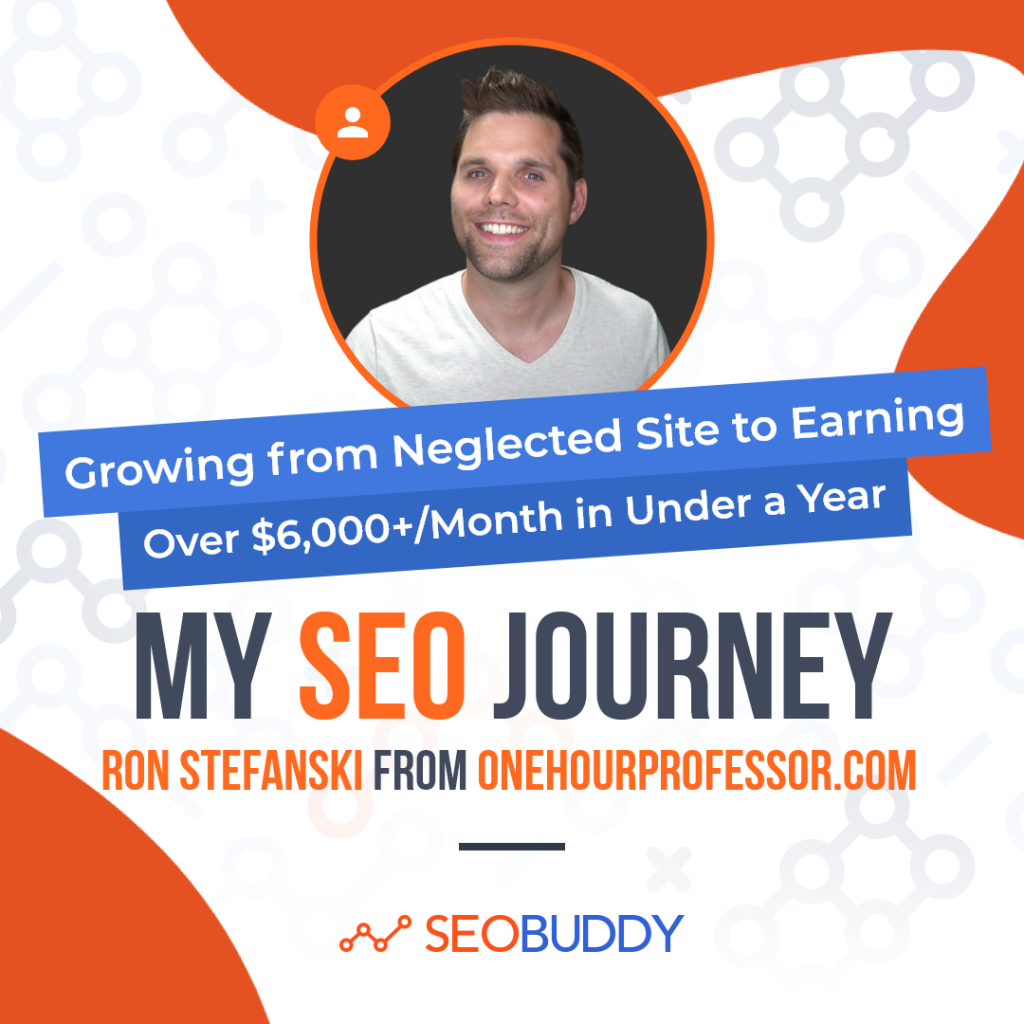
Hi, my name is Ron and I’m the creator of OneHourProfessor.com.
I’ve been at this online business stuff since 2014 and you may have heard of me before as I’ve been featured in a lot of places (or maybe you haven’t). Either way, I’m one of the “old-timers” in this space and have had some pretty great milestones along the way.
- I made my first dollar online in September 2014,
- I had my first $20,000 of earnings month in September of 2019,
- In FY2020, my online business made me $184,669 in net income,
- In February of 2021, I sold a website of mine for $277,000,
- In 2021, I’m slated to surpass over $1,000,000 in net income since I started.
All of these milestones have been great, but there’s one challenge I’ve taken on recently that could eclipse all of this, and it’s on a heck of a trajectory.
But, in order to explain why this challenge is so important to me, I have to bring you back in time and tell you a quick story.
—–
The year was 2014 and I was a wide-eyed idiot who thought I could unseat Pat Flynn from SmartPassiveIncome.com as the “online business” expert everyone would trust.
My reasoning was simple. Aside from being in digital marketing for 7 years, I also taught digital marketing courses at a few different colleges in my spare time.
Having that experience, I thought it was time to launch a site to teach people how to create and grow an online business.
I launched OneHourProfessor.com and pushed hard to create courses and show people what I had learned with my years of corporate experience.
Below is a screenshot of what my site once looked like:
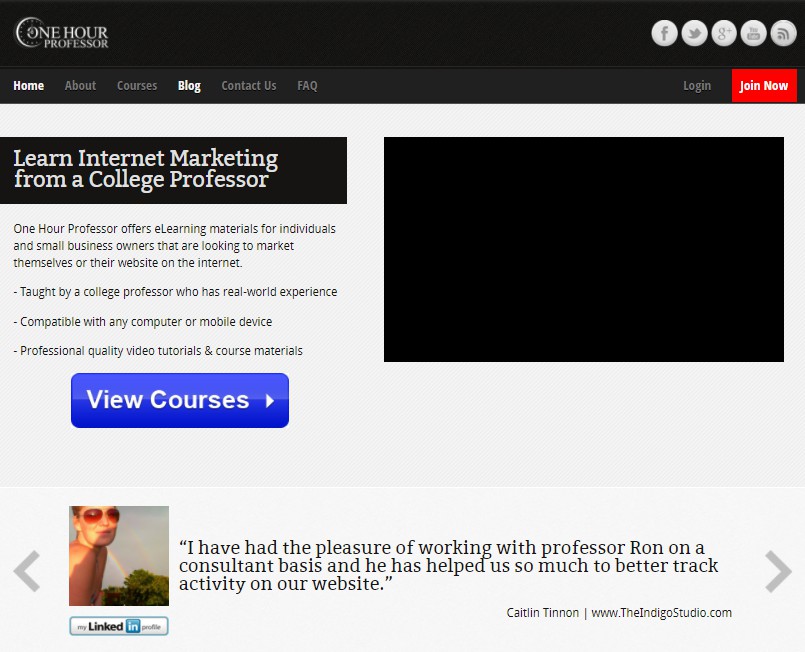
And due to my credentials and knowledge, it was a runaway success. Right?!?!?!
Wrong.
It turns out, no one cares about credentials. They care about what results you’ve produced.
So, after 6 months of hard work I realized that people want to learn from folks who have had success, not those who speak about hypotheticals and theory (duh).
At that point, I put my head down and built websites while writing an income report every single month for OneHourProfessor to track my online business successes and failures.
Some of the sites I built were stupid, and many of them were failures.
But eventually, a site hit and I was able to grow it to over $15,000 in earnings every single month.
Then I realized, I could do it again…..and so I did.
Over and over until I had 8 successful websites and was making over $25,000 a month.
But, I felt a void.
You see, I’m a natural born teacher. In fact, I still vividly remember my mom telling me when I was a kid that I should be a teacher.
And teaching others at a collegiate level while making money from my own online business has been great.
But you know what is greater than that to me?
Knowing that someone followed my advice with an online business and was able to pay their mortgage because of me. Or, they’re able to take their family on a trip to Disneyworld. Or, maybe just something as simple as taking their family out to a nice dinner every month.
So, in July of 2020, I decided to focus on that old, failed website of mine called OneHourProfessor because this time, I had quite a bit of success and could teach people what I knew from experience.
But how….
How could I revitalize a site that was basically sitting around since 2015?
That’s what this blog post is all about.
I want to tell you how I’ve been able to take a site I used to blog on once a month for 5 years that made a couple hundred bucks a month to something that currently:

- Has a domain rating of 71
- Makes over $6,000 per month
- Has 75,000+ monthly visits, 9 months into my relaunch
- Continues to grow at an astronomical rate month to month, with 90%+ of traffic coming from organic search.
Before we begin, here are a few screenshots to help you understand what I’ve been able to achieve. Keep in mind, I started this strategy in July of 2020.
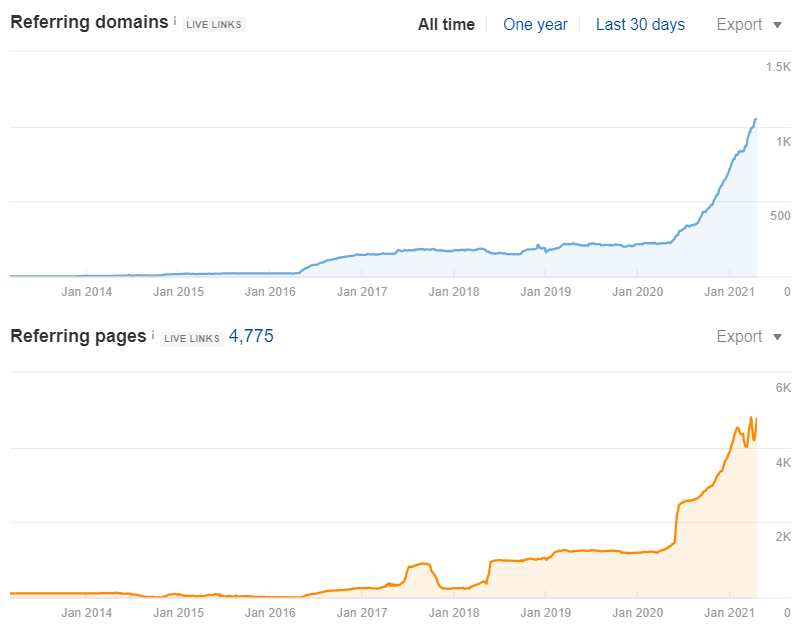
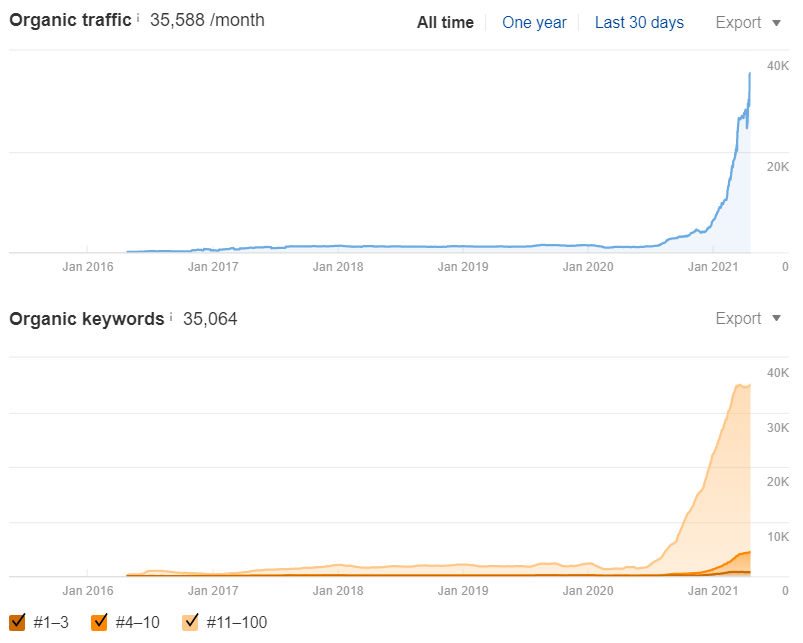
Step 1. The Blogging Purge
Step one in my master plan was to get rid of all of the content that simply didn’t make sense to have on the blog any more. You see, when I first started blogging on the OHP site I was focused on getting as much traffic as possible.
This meant I was writing random posts about random internet marketing topics, doing anything I could to try to rank and get some traffic to the site.
While I did rank for some of the posts I wrote, majority of these posts sat on my blog as a published (and forgotten/neglected) piece of content.
They didn’t bring in any traffic, they didn’t create any value for my readers, they didn’t have internal links pointing to and from them, and they took up crawl budget of my site and gave it more bloat in the eyes of search engines.
So, I took a deep dive into Google Analytics and scrubbed my site of any posts that had no traffic for the last 6 months.
While this was painful to do because I took my time writing the posts, I came to terms with the fact that they never brought in much traffic and weren’t really on-brand for what I wanted to build in the future.
After the purge, I went from around 110 blog posts to roughly 45, which was a great consolidation of my content. And this is our search traffic for the past 12 months:

Step 2. Creating BETTER content
The next step in my master plan was to make the posts that already had some traffic even better.
While the majority of the posts I kept on my site were income reports, which didn’t always have traffic but were on-point for my brand, there was a handful of posts that were still getting traffic and could benefit from a refresh.
Knowing this, I took the time to review/polish each of these pieces of content to bring them up to the quality level that Google requires.
I did this for roughly 12 pieces of content and, from what I can recall, majority of them saw a traffic increase after the refresh was completed.
Now that my content was updated, it was time to review my content strategy and quality for new content.
After reviewing what I did before and knowing why it failed, I decided to spend most of my time researching topics that would bring in the people I wanted to connect with to build my community.
In other words, I would do my keyword research and then try to determine user intent with that keyword list to find the right topics regardless of competition.
This is in stark contrast to how I built my other sites in the past, but I figured the online business niche would be extremely competitive.
A good example of this is how I created a post all about the best online course platforms.
I choose to write this post for a few reasons:
- Online courses are an amazing way for someone, even someone with a small audience, to make money with an online business.
- If someone is searching about online course platforms in Google, they (assumably) already have an audience to sell courses to.
- This search query has many affiliate partners, so it’s a post that can be highly profitable if I rank.
- I intended on eventually creating a guide for all different types of online business tools, so this was a good place to start.
Once I had the topic nailed down, I paid very close attention to the Google search results to see what the top 5 posts on Google had in common. I noted the content they created, the structure of their posts, how many backlinks they had, and tried to really understand what Google was looking for when it came to formatting.
I then used Surfer SEO to help me analyze the results and I have to say that it has been immensely helpful in the process. That software allows me to find all of the key indicators and information at a glance.
Step 3. My Strategy to Becoming an Authority
The next step in the process was to become an authority in the online business niche.
Even though my site had been around for many years and I did have a small following and some authority, the only way I’d be able to potentially rank any of the posts I created was to grow my authority by being featured in other places.
This is because the niche of online business is just too competitive and nearly every single one of my opponents had a high scoring domain rating.
Due to this, I decided that my best course of action was to use guest posting to grow my authority.
So, that’s exactly what I did in July of 2020.
I had my virtual assistant who helps me with my business as a whole research to find a list of different business/marketing blog that allow guest posting.
But the key to this strategy is I focused on sites that had a high domain rating, Generally speaking, I focused on the Ahrefs metric of DR with 50+.
From there, I reached out individually to each of the publications and tried to pitch them so that I could get featured as a guest contributor.
This isn’t easy because these places get so many pitches every single day, so I did my best to pitch topics that weren’t just good for their audience, but could potentially steal away traffic from competitors.
Here are some of the top guest blogs we were able to publish:
https://www.socialmediaexaminer.com/how-to-optimize-youtube-videos-for-google-search-visibility/
https://www.wordstream.com/blog/ws/2020/08/27/lsi-keywords
https://www.thinkific.com/blog/digital-marketing-tips/
Step 4. Simply. Hard. Work.
This part of the process was undoubtedly the hardest part. To be honest, I was working far too hard in this step and realized quickly that what I was doing wasn’t sustainable.
Not only was I pitching all of the different outlets I wanted to get featured in, but I was answering all of the emails for negotiating guest posting opportunities, reaching out to each editor individually to create a relationship, creating an article outline for each topic that got approved, writing all of the guest posts, following up after guest posts were submitted, writing my own posts on One Hour Professor, and still took the time to manage my portfolio of sites and the people on charge of them.
This was without a doubt the most challenging part of my master plan.
There were so many different little tasks to be done and I was at this stage for about two months before I was finally comfortable with the idea of outsourcing some parts of the process.
While I’m always a huge fan of outsourcing, it was especially difficult for me to outsource any of this because I was the person behind the brand and whatever I created was a reflection of my knowledge and expertise.
And, considering I’ve been at this for a long time, I typically have a greater understanding and depth of knowledge than most other people.
These factors made me spend weeks on end working over 14 hours a day. It seemed that every time I got something done, two or three more things needed to be done and it was a lot of long hours and sleepless nights to start making progress.
The graph below shows that my strategy worked very well, even when I was managing all parts of the process.
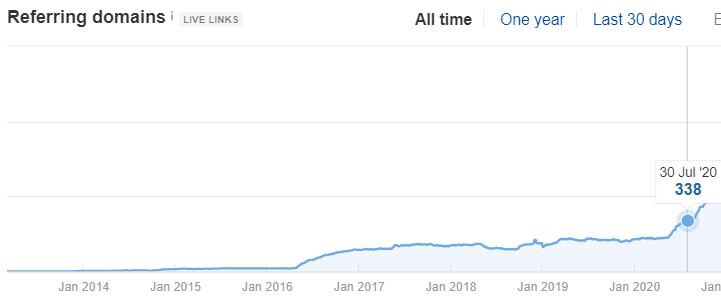
Once I started making progress, and I began to formulate a consistent process, I realized that I would be able to outsource bits and pieces of the process.
Step 5. Outsourcing to Scale
At this stage, I needed to find ways to outsource what I was doing to scale my efforts and keep my sanity.
First, I decided that I was going to become less of a writer and more of an editor for the content I was creating on my own site. This meant I would create all the outlines for my content on my site after doing an analysis of the SERP to determine what Google was looking for, but I would hand it off to someone else to complete the writing.
This was very difficult for me because OneHourProfessor is a personal blog, but I’ve done this before with other brands I own, and it worked well. I ended up finding someone on the ProBlogger job board who is good at digital marketing but is unquestionably a better writer.
This is perfect because they create a post that’s both informational and enjoyable to read, and I review what’s being said and throw in my own anecdotes and observations within.
I still spend time writing certain posts of my own as I can’t outsource everything, but having this individual on staff has helped me increase my output significantly.
Second, I hired someone to help me write topics to pitch for guest posts and create article outlines for my newly appointed writer to follow when they are assigned a topic. While this may not seem like a lot of work, it absolutely is as I take great care when I pitch an editor on potential topics. I do my best to make my pitches stand out and sometimes it can take up to an hour to pitch 3 topics, so this was a time saver.
Third, and I only did this after the first step was achieved and very successful, I decided to outsource some parts of the writing for the actual guest posts I create. My thought process here is simple. With OneHourProfessor I always create the best content possible and the writer I have can help significantly with that, so I wanted to see how well they could create guest posts. Lucky for me, their writing is (often) better written than my own posts and all I have to do is go through with the editor’s eye to make sure what is being said is factual, helpful, and I can interject my own thoughts/quotes along the way.
Fourth, I took the time to explain the process of communicating with potential prospects about guest posting opportunities so that I could outsource a weekly check-in with each “hot” lead. This is essentially an assistant of mine reaching out as myself to potential guest posting opportunities to see if they’ll allow me to write on their blog. I’ve found that this is incredibly important because it’s really common for editors to get busy and (on accident, or maybe on purpose) temporarily ignore your emails.
Fifth, and this is still to be completed, I’d like to outsource my communications with potential prospects entirely so that guest posts are getting secured and written without my intervention. From there, I would review the posts and edit them prior to sending them off to make sure they meet my quality standards. While I’m not at this point yet, I’m working on the training now to make this a reality. Being able to hand this off would be amazing because it’ll allow me to focus on big-picture strategy and scale site growth.

Now it’s time to discover the other 102 steps that will get more organic traffic flowing to your website. Get the SEO Checklist here.
Want to get a sneak peek of what it looks like?
Enter your email and get a free demo version of the SEO Checklist.
Step 6. Revisions and Networking
I think that of all the steps listed in this post, this may be the most important one.
The final step of the process is focused on revising One Hour Professor content to not only refresh the publish date in the eyes of Google but also add more “meat” to the content and make it more valuable for the users.
I’ve found that in terms of best ROI on my time to increase traffic to my site, this is by far the top strategy to grow.
I think this is because I often have content created that I think is great, and then Google looks at it compared to my top competitors and sees what it likes/dislikes about the article.
I then let the article sit for a couple of weeks on my site to see how Google ranks it and if the results aren’t as favorable as I was hoping (at least page 1) then I take the time to make the articles a little better.
I do this process over and over again every couple of weeks until I hit on the points Google is looking for and I get ranked on the first page of Google.
It’s funny because I was against revising articles for so many years as it annoyed me to do this task, but it really is the most important part nowadays.
The other thing that has helped me is networking.
Because my site has also developed domain authority, I’ve noticed that I’ve received many more outreach emails from people who are looking to get their tool or product featured on my site.
While I don’t always grant them their wish, I do make it a point to try to establish real relationships with them and grow my network. I’ve found that doing this can help me outreach to even better contacts because the world is a smaller place than you think and I’m able to get contacts to refer me to other contacts in their network.



